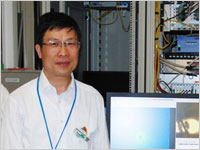The Royal Swedish Academy of Sciences is now recognising outstanding research into two enzyme systems that are of vital importance to life on Earth. Jian-Ren Shen has studied a photosynthesis enzyme in plants and bacteria, while Douglas Rees has studied nitrogenases, which fix nitrogen. The two researchers are to receive this year’s Gregori Aminoff Prize for their work.
Enzymes are protein molecules that drive the chemical reactions found in all living things. They are the foundation for the chemistry of life.

Jian-Ren Shen has studied a photosynthesis enzyme in plants and photosynthetic bacteria, called photosystem II. Because of photosystem II, green plants and cyanobacteria can absorb carbon dioxide and water and transform them into glucose and molecular oxygen using sunlight as the source of energy. Without photosynthesis, we would have no molecular oxygen in the atmosphere at all.

Douglas Rees has studied nitrogenases, which fix atmospheric nitrogen and are found in some bacteria. Almost 80 per cent of the Earth’s atmosphere consists of nitrogen. Organically fixed nitrogen is essential for life on Earth and is included in many of the molecules of life, such as DNA. In nature, the dominant form of nitrogen fixation is bacterial, so bacterial nitrogenase is decisive for life on Earth.
Challenging studies
However, studying these two enzyme systems is challenging. Both systems transfer electrons between different molecules, something researchers call redox reactions. They can do this because they contain large clusters of metal that act as temporary storage for the electrons. In photosystem II this is a cluster of manganese ions and in nitrogenase it is usually iron.
The X-ray radiation used in the study of these systems’ structures tends to change the oxidation state of the metal ions, which means the image produced is not always the same as the way enzymes look in their natural state. Nitrogenase has another difficulty, as the entire system is oxygen-sensitive and must be protected at every stage of the purification and crystallisation process.
For photosystem II, one way of removing the problem is to use short pulses of high intensity X-ray radiation. This allows enough information about the structure to be collected during one pulse. No redox processes can take place in the short duration of the pulse, and the information from the experiment thus describes the undamaged system.
Understanding of basic processes
Structural data from X-ray studies is extremely important information that provides understanding of the basic processes of life. This allows researchers to model natural processes and perhaps even to learn ways of copying nature’s clever solutions to important problems.
Jian-Ren Shen and Douglas Rees lead research groups that have succeeded in studying numerous different states in enzymes, which has led to an understanding of how nature drives photosynthesis and fixes atmospheric nitrogen using enzymatic processes.
Laureates:
Douglas Rees, Professor at California Institute of Technology, USA.
Jian-Ren Shen, Professor at Okayama University, Japan.
They are awarded the prize for “their fundamental contributions to the understanding of biological redox metal clusters”.
The Aminoff Prize:
The Royal Swedish Academy of Sciences awards the Gregori Aminoff Prize in Crystallography every year. Crystallography is the study of atomic structures in solid materials and is used in chemistry, biology, medicine, geology and materials science.
The prize should reward a documented, individual contribution in the field of crystallography. It has been awarded to Swedish and foreign researchers since 1979. The prize amount is 120,000 Swedish krona.
Contact:
Pär Nordlund,
Chairman of the Prize Committee,
par.nordlund@ki.se,
+46-70-433 66 88
Press Contact:
Eva Nevelius,
Press Secretary at the Royal Swedish Academy of Sciences,
eva.nevelius@kva.se,
+46-70-878 67 63